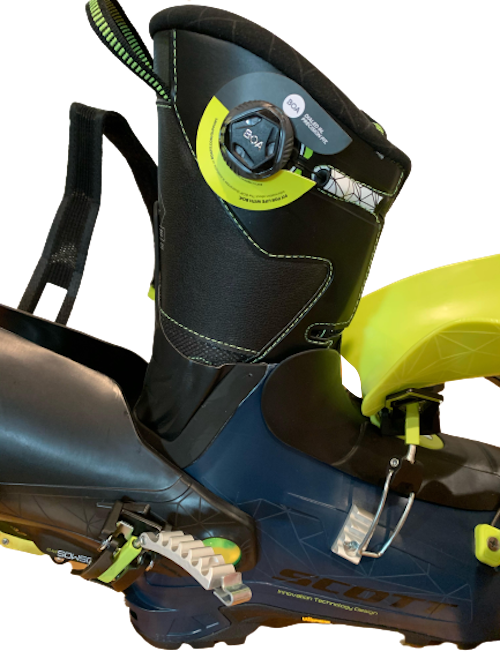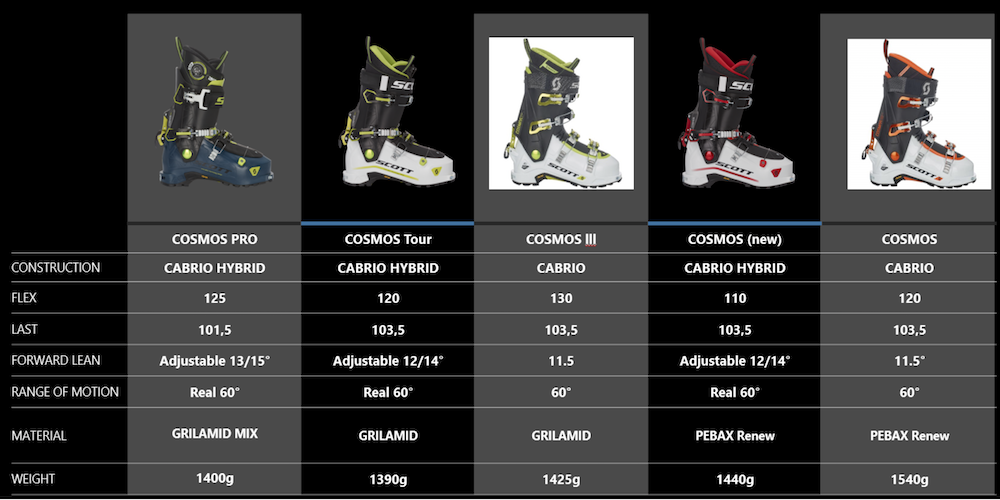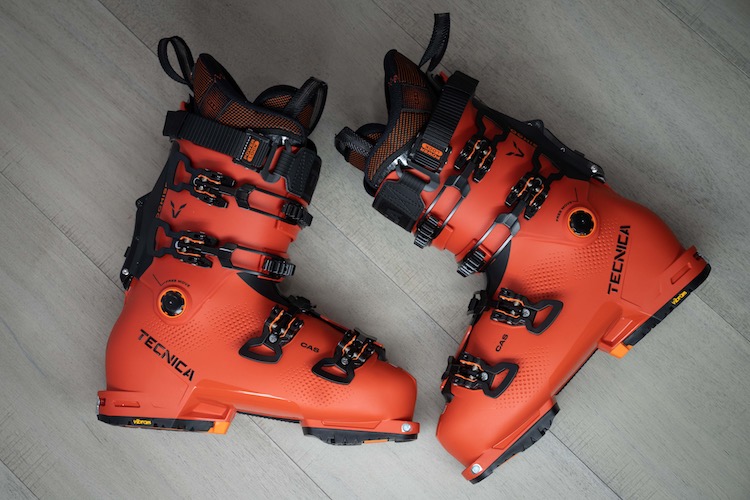
The magenta Gea RS and Aqua Maestrale RS feature new more sustainable materials, the Walk XT ski/walk mechanism, and fancy exoskeleton cuffs and shells to help transfer power through the boot.
Touring boots are the keystone of the equipment necessary to move in the mountains. Without them, your feet would be freezing, vulnerable, wet, and not be able to click into touring bindings. With them, you can glide uphill, slide downhill, and walk to and from your car in the parking lot without the signature resort-boot-cowboy-gait.
We have filtered through the ski touring industry to see what’s new for the 2021 season. The general theme for the development happening this season is: conservative. There are no crazy, space-age developments set to revolutionize the touring world come Fall 2021. However, what is notable within the industry are minor improvements on already great equipment. Incremental steady change in the positive direction seems to be a great responsible decision. Nice one ski touring industry. So without further adieu, let’s get into the new boots for the 2021 season:
Redesigned Scarpa Maestrale/Gea & Ladies F1LT
The Women’s Gea and Men’s Maestrale are the quintessential mid-range touring boot. A middle ground between uphill and downhill performance. Scarpa says they are ‘the world’s best selling and highest performing backcountry ski boot.’ We’ll reserve such judgement. But I sure do see quite a few of them on the skin track each season. For 2021, they both receive incremental improvements to move a step forward in their ski boot design fame.
The boots get a shell and cuff redesign that includes an I-beam style construction. Scarpa calls this 3D Lambda Frame and it more effectively transfers power from the foot to the ski without increasing the flex of the boot. We saw the advent of 3D Lambda Frame with the F1 LT last season, which reviewers reported to improve the downhill performance compared to its Alien RS predecessor. The Gea/Maestrale also gets a new ski/walk mechanism: the Speed Walk XT. This mechanism comes straight from the beefier Maestrale XT. The Speed Walk XT has shown to be reliable and stable with a dual-point connection from the shell to the cuff. An improved, more ergonomic finger strap is another nice addition to the new and improved boot series.
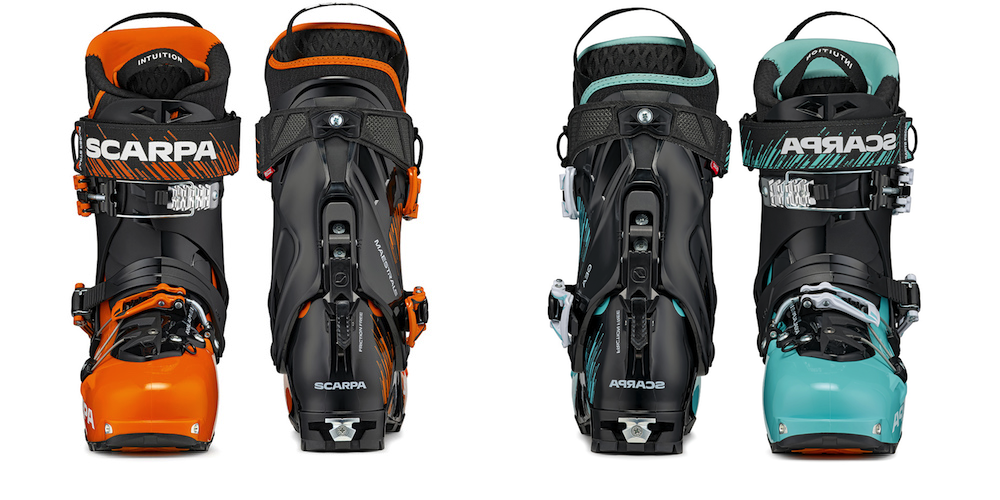
The orange Maestrale and teal Gea are the same design as their RS counterparts, but made from Pebex Renew instead of Grilamid Bio.
The Gea/Maestrale and the Gea RS/Maestrale RS are made from more sustainable materials — Pebex Renew and Grilamid Bio respectively. Both materials are made from castor beans, which can grow on arid land where other agriculture is typically less fruitful. This ag development doesn’t compete with food production and also offers an economy in places where other agriculture can’t otherwise take place. No crazy boot hacks with the new Gea and Maestrale, just smart improvements to an already great boot series. The Maestrale and Gea RS (1450 and 1250 grams per boot), and Maestrale and Gea (1440 and 1240 grams per boot) will be out Fall 2021.
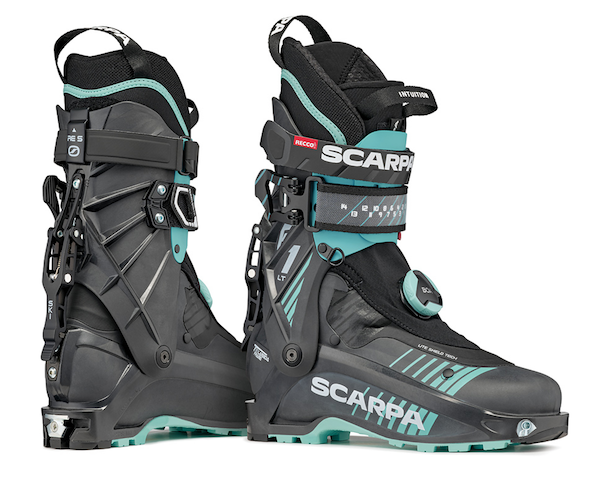
The Women’s F1 LT comes in a nice teal. This boot will take small-footed people through the backcountry at warp speeds.
Also new to Scarpa is the Women’s F1 LT. This ultralight high performance touring boot is a becoming a quick favorite among the local touring crowd. Cheers to Scarpa for adding a female specific model. The difference between the existing F1 LT and the F1 LT WMN is a lower cuff for women’s calves which I’ve been told are on average lower on the leg. They will also be provided in smaller sizes for smaller feet, down to 22.5.
Scott Cosmos Series
Scott redesigned their Cosmos series with a total of five new boots (!): The Cosmos Pro, Cosmos Tour, Cosmos, Celeste Tour, and Celeste. In 2012, Scott entered the ski boot market by purchasing footwear manufacturer Garmont. The Scott Cosmos has stacked redesigns on top of the original Garmont boot mold. However, 2021 marks a new era of Cosmos boots with a divergence away from the original Garmont shell. (See our Scott boot coverage over the years)

The full Scott Cosmos line up is a step away from the original Garmont design. The boots now feature a three buckle design, an extended range of motion, but the same wide forefoot shape in the shell.
Scott bases the new series off of a cabrio hybrid design debuted last season with their Freeguide Carbon boot (Check our first impression of the boot here). The real advantage of a cabrio design is the progressive flex — the more you flex into the boot, the more resistance is created by the tongue of the boot.
So what’s new with the new Scott Cosmos? The cabrio hybrid design is novel and will provide a different flex profile from most other overlap touring boots. The buckle system is a combination of the old Cosmos and the new Freeguide Carbon (the Pro shares the FGC cuff buckle/strap and the other models use a traditional ratchet-style buckle). All of the models move to a three buckle design. The range of motion in comparison to the old Cosmos is improved with the addition of a neoprene wrap around the Achilles of the shell/cuff interface. This gives the boot an added range of motion in the negative direction that creates a more natural touring stride.
Scott holds a reputation for high volume fit. The former Cosmos was a high volume boot with a healthy 103.5 mm last and roomy lower shell. The Cosmos Pro will come in a 101.5 mm last while the Cosmos Tour and Cosmos (ladies equivalents are the Celeste Tour and Celeste) maintain a HV 103.5 mm last. The Pro shell is actually the same shell as the Tour and Original. The difference of shape between the two is the liner thickness and density.
The Cosmos Series is a collection of boots for all of the wide forefoot backcountry travelers that shiver at the idea of forcing their foot into a 98 mm last boot. They are traditional touring boots that aren’t crazy lightweight, nor freeride firebirds. They will deliver a fun time while ski touring, all while providing the interior space for the widest of forefeet.
Dynafit: Mezzalama & DNA, Radical & Radical Pro
This season Dynafit is making big moves across the board with boot development. They have new boots in the touring, lightweight, and race categories. Before getting into the new boots, here’s an overview of Dynafit’s categories:
Free (freeride skiing): A priority in downhill performance. Boots should fit tight with no slop. (ex. Hoji Free 130)
Tour (traditional touring): A priority in all day comfort. Boots have a wider last, softer flex, and comfortable out-of-box fit. (ex. Radical)
Speed (fitness/fast touring): A priority in uphill comfort at higher speeds. Boots have an easy-going comfort fit. (ex. TLT8)
Race (randonee racing): A priority in range of motion and weight. Boots are super fast but tough to fit (ex. Mezzalama and DNA).
The Radical Pro and Radical are new boots that fill into the Tour category for Dynafit. They are both intended to fit comfortably out of the box, ski comfortably both up and down in the backcountry, and comfortably hang out in the parking lot over a post-tour beverage.
The Radical Pro uses the Hoji Lock that transitions the boot from ski to walk mode in one step (huge convenience points). This looks like a classic high performance touring boot and holds strikingly similar to the beloved and long-lost TLT6 Performance CR… The boot is made from carbon-infused Grilamid, weighs 1380 grams, has a 103.5 mm last (on the very wide end of the boot fitting spectrum), and has a claimed flex of 120.
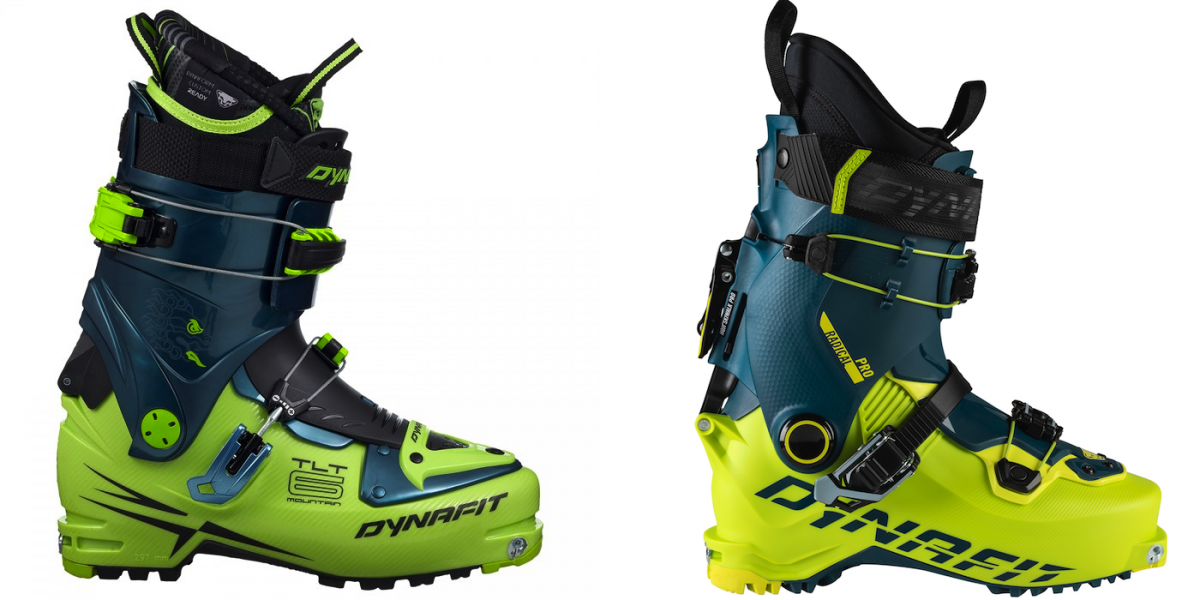
The TLT6 Performance CR on the left, the Radical Pro on the right. The Radical Pro isn’t an update on this cult classic boot, but it looks pretty similar…
The Radical employs the Hoji Single Lock which is a two step transitions process. It is made from PU, weights 1520 grams, has a claimed 110 flex, and shares the 103.5 mm last with the Radical Pro. The Radical is a less radical version of the Radical Pro, which in a lot of cases can be a good thing. More stiffness in a boot doesn’t mean more performance. The intent with boot flex is to match it with your skier ability and general size. It’s nice to flex into a boot instead of hitting a brick wall of boot stiffness. (*Just a small side rant worth of consideration*)
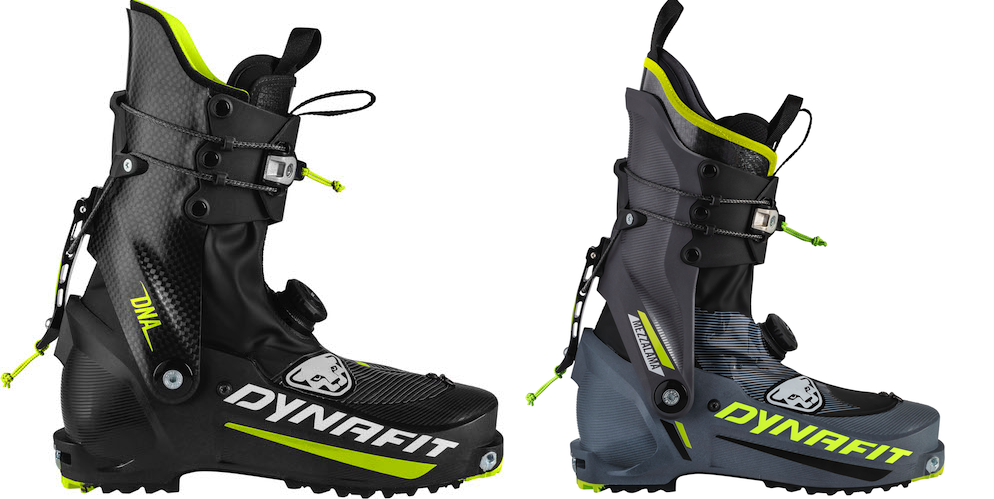
The DNA on the left (800 grams) and the Mezzalama on the right (865 grams). These are upgrades for the Dynafit race boot series. A Twistfit (similar to BOA) closure system secures the lower foot. A Racelock system acts as both the ski/walk mech and cuff closure.
The second inclusion to the Dynafit 2021 boot development party is a whole new race boot series with the training-oriented Mezzalama and the race-oriented DNA. These boots share a shell and cuff design, but the DNA features a carbon fiber cuff while the Mezzlama has a Grilamid cuff. Both feature Dynafit’s new Twistfit shell closure that is a direct competitor to BOA, and looks to function similarly. The ski/walk mech and cuff closure is another Dynafit design called Racelock. Racelock looks similar to the Alien RS cuff closure system. I’m excited about the vertical ski/walk mech lever and anticipate it to be an improvement from the sideways Ultralock closure of the PDG 2. No more catching poles on the walk mech while ski-jogging uphill. Thanks Dynafit for supporting us skinny ski randonee nerds with a new and improved race boot.
Tecnica Cochise
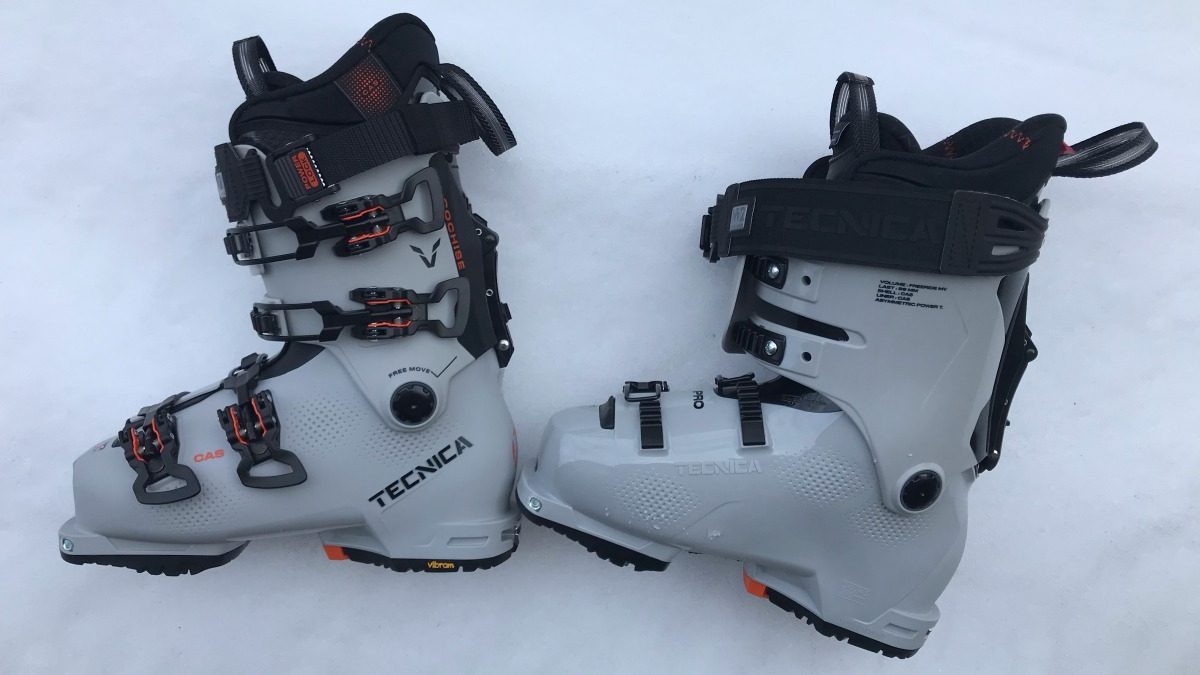
The Tecnica Cochise W Pro — with 4 different flexes, there are more women’s versions of this boot then men’s!
The Blizzard Cochise is redesigned for the 2021 season. This boot sits on the far, far end of the uphill vs. downhill performance spectrum. The side of the spectrum where words are thrown around like ‘Alaskan spines’, ‘mouth guard and back brace check’, and ‘three-degree bevel’. These boots as mentioned by Tecnica are ‘high performance downhill ski boots that walk.’ But the Cochise already holds this reputation in the backcountry ski world. What changed with the redesigned Cochise to further build this reputation?
Tecnica worked with their team of world renowned boot fitters (more on that team and bootfitting here) to shape the new Cochise into a more anatomically correct fit. Boot fit is important, especially when you’re trying to squeak every gram of performance out of a boot.
In line with their redesign of the shell and cuff to be more anatomically correct, the Cochise liner is updated to do the same: an asymmetric shape to match human ankle/heel geometry and built from high density (even more so than before) customizable foam.
The last added update to this boot is a redesigned external ski/walk mechanism. This mech works similar to the Zero G where it’s a dual-point connection that contacts metal on metal at two locations both above and below the cuff/shell interface. There is also an included dial lock out that ensures the boot remains set into ski mode. External walk mechs are great because when they break (everything eventually breaks) you can see what’s wrong and how to fix it.
It’s not about the numbers for this boot. No gram counting. No ROM measuring. This is a downhill oriented touring boot through and through. There is no carbon fiber or Grilamid. It’s a full PU build because that’s what delivers the best downhill performance, regardless of the added weight. The Cochise will come in five different models according to flex pattern: the women’s 120, 95, and 85 (the 85 doesn’t have tech inserts) and the men’s 130 and 120. The introduction of the women’s 120 is a step forward with female boot design in stating the obvious: women can charge in the backcountry and demand a boot for that.
La Sportiva Vanguard
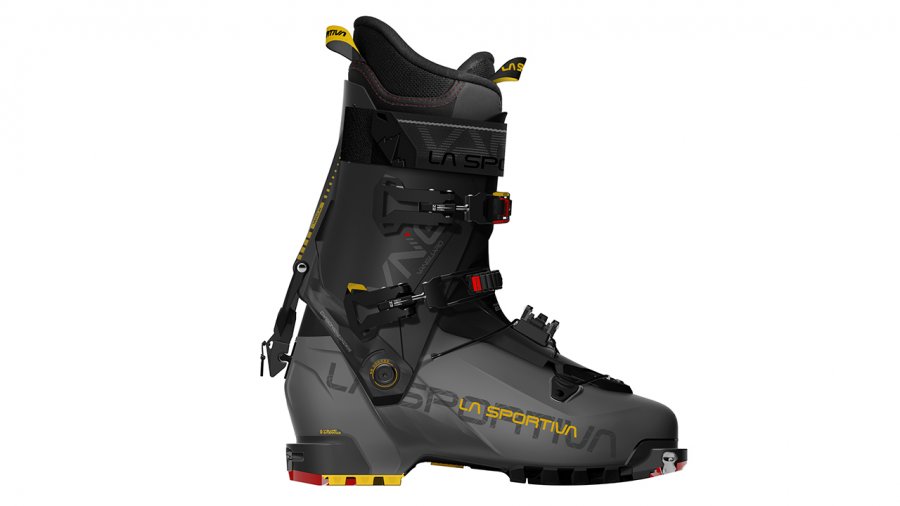
The La Sportiva Vanguard has a lot of new technology combined to make a mid-range touring boot with plenty of new design features.
The La Sportiva Vangaurd is a mid range touring boot that features a lot of new technologies. The Italians at LS always do a great job with innovative design, but the Vanguard looks to be a step above the norm in that respect.
The V-SHAPE cuff works similar to the Dalbello Quantum, being a locking cuff coming from both in front and behind the leg.
An EZ-FLEX Double Tongue is a two part tongue that has varying densities to help provide better range of motion for the way up. The COMPACT buckle is an ankle/heel pocket buckle that can stay connected while in walk mode and keep a svelte profile against the boot.
The Vanguard is a full Pebex Renew construction, features a 130 (mens) and 115 (womens) flex and weighs 1450 grams. We’ll have more thoughts and opinions once we get it on the skintrack.
Fischer Transalp Boots
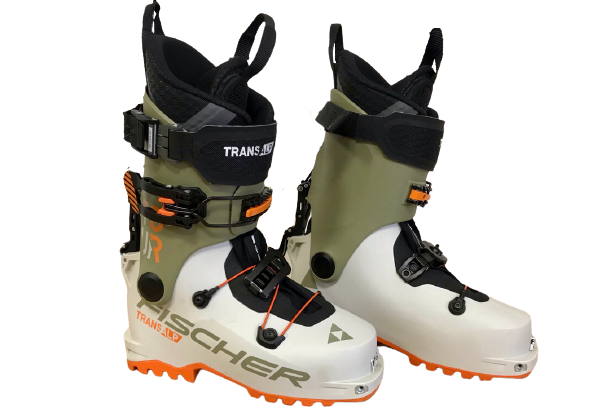
The Transalp is a standard two-buckle design with a robust cuff strap. It includes an external ski/walk mech, traditional buckles and easy to customize plastic.
Manasseh wrote a full length first look of the Fischer Transalp series here. The general idea is that we’re excited to see more touring brands like Fischer build boots for the average backcountry user. The Transalp is an easy-to-use, easy-to-tour, easy-to-casually-ski-downhill kind of boot. No special bells and whistles, no fancy carbon this or hard-charging that. At 1270 grams with a 120 flex and reported 80 degree range of motion, it’s a touring boot that will get you into the mountains and back with a smile and not-too-tired legs.
2021 Backcountry Boot Wrap-Up
The ski touring industry has seen focused development within the touring category. Touring you say…that’s vague. Well, a traditional touring boot is not ultralight and it’s also not ultraheavy. Touring boots are typically two or three buckle shoes that are midrange in weight, performance and price. They are intended to ski uphill and downhill with balance. Touring boots accommodate the majority of us backcountry users. It’s exciting that the ski touring industry is making gear for us common folks. Of course, there are people on both ends of the bell curve of boot user cases. There is the weight weenie that wants an ultralight boot to log vert and cross monster amounts of mountainous terrain (think Dynafit DNA). There is also the freerider that wants to ski fast, huck cliffs, and be their very own TGR-star (think Tecnica Cochise). But what about all of us in the middle (think Fischer Transalp or Scarpa Gea)? We are the majority: us backcountry users that hope to go for a ski tour with friends or family. To comfortably tour up, then wiggle down some fresh snow. No uphill intervals and no double backies are included in our tour plans. So thank you ski touring industry for pushing boot development for the majority of backcountry users. We appreciate it.
Readers: What do you think? What did we miss?
Slator Aplin lives in the San Juans. He enjoys time spent in the mountains, pastries paired with coffee, and adventures-gone-wrong. You can often find him outside Telluride’s local bakery — Baked in Telluride.

